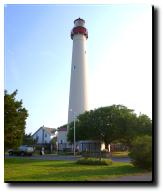Cape May Lighthouse
c/o Mid-Atlantic Center for the Arts
PO Box 340
1048 Washington Street
Cape May, NJ 08204
(609) 884-5404 - (800) 852-7899
http://www.capemaymac.org/attractions/capemaylighthouse.php
 The Cape May Lighthouse is one of the oldest continually operating lighthouses in the United States. It has helped navigators enter the Delaware Bay since 1859 and is listed in the State and National Registers of Historic Places.
The Cape May Lighthouse is one of the oldest continually operating lighthouses in the United States. It has helped navigators enter the Delaware Bay since 1859 and is listed in the State and National Registers of Historic Places.
The current tower is the third such structure to be built on the site. The first, erected in 1823, stood 68 feet tall. It sat on land that is now covered by water, about 100 yards off the current shoreline. Undermined by erosion, the tower fell into the sea. Bricks from that original lighthouse occasionally wash ashore during storms.
The second lighthouse was constructed in 1847. Due to its poor design, this 78-foot tower was eventually demolished.
In 1857, the Army Corps of Engineers began construction of' the present lighthouse. The cost of the 157-foot tower, plus two keepers' dwellings, was about $40,000. The tower is made of brick, with both an exterior and interior wall. The outside wall is conical, with a diameter of 27 feet at the base and 10 feet, 6 inches at the top. The cylindrical interior wall supports the 199 step, cast-iron spiral staircase. Both walls rise 145 feet to the watch room and outside gallery (current viewing platform), which sit beneath the lantern at the top.
The beacon was first lit October 31, 1859. Its original lamp was fueled by oil light from that oil lamp was focused into a straight beam by a unique Fresnel lens, made by Henry Lepante of France, at a cost of about $30,000. This original lens was so large that a lighthouse keeper could stand inside it to refuel the oil lamp. The lens is now on display at the Cape May County Historical Museum in Cape May Court House.
In 1938, the original oil lamp was replaced by an electrical beacon, which eliminated the need for lighthouse keepers. Today, this beacon flashes every 10 seconds and is visible 24 miles out to sea.
The United States Lighthouse Service was discontinued in 1939. Its equipment and personnel were transferred to the United States Coast Guard.
As electronic navigation aids began to reduce the need for lighthouses, the Cape May Lighthouse fell victim to Coast Guard budget cuts. During World War II, the Lighthouse was darkened while serving as a watchtower for enemy submarines. The beacon was reactivated at the end of the war, and has continued to serve as an active aid to navigation.
Because of limited federal funds, the Coast Guard has begun to lease lighthouses around the country to groups willing to maintain and restore the structures. In 1983, the Mid-Atlantic Center for the Arts (MAC), Victorian Cape May's leader in historic preservation and the performing arts, expressed interest in restoring the Cape May Lighthouse to its original condition. In December 1986, MAC leased the Lighthouse from the State of New Jersey, with the mission of restoring, maintaining, and opening the structure to the public. MAC opened the ground floor to the public on July 18, 1987, and the full tower on May 28, 1988.
The restoration of the Cape May Lighthouse reached another milestone on Sept. 19, 1992, with the transfer of ownership from the Coast Guard to the State of New Jersey, thereby making the Lighthouse eligible for substantial matching grants from the New Jersey Historic Trust.
In 1989-90, MAC restored the tower's windows and doors and completely restored the Oil House on the Lighthouse grounds, creating a fully accessible visitors orientation center. In the Oil House, visitors who cannot climb the tower's staircase can see the view from the Lighthouse in a vivid photo mural, reproductions of the information exhibits on display in the tower, and a 12-minute video depicting the climb to the top. The Oil House also contains the Lighthouse Museum Shop with a fascinating array of lighthouse nautical memorabilia and souvenirs for sale.
In 1993-94, the lantern and roof were completely overhauled and the tower was repainted in its original colors, a mortar wash with white window trim. Included in the interior restoration of 1997-98 was the Vestibule House hallway and oil storage closets, the brick masonry throughout the Tower, the iron-work throughout the Tower, including the 199 steps and handrails, the Watch Room, and installation of a fire detection and security system, including upgrading the Security Grille around the Watch Gallery.
In 2000-01, MAC restored the stonework of the Lighthouse foundation, conducted an archaeological investigation of the Lighthouse grounds, restored the brick walks and installed an ornamental security fence around the Lighthouse grounds.
Today, the Lighthouse is one of the most popular attractions on the Jersey Cape. With its scenic setting in Cape May Point State Park, the Lighthouse has also become a popular site for weddings and engagements, as well as other gatherings.
Photo by Craig Terry, courtesy of MAC
|
Hours: Open daily, April through November and on weekends most of the rest of the year. Hours vary, so please call before visiting. |
|||||
|
Admission: |
|||||
|
Adults $7.00 |
|||||
|
Groups: Call for Group rate information. |
|||||
|
Group Reservations: At least 1 week in advance. |
|||||
|
Lunch: Local restaurants. Picnic in park. |
|||||
|
Handicapped: Partially accessible. |
|||||
|
Directions: Garden State Parkway south to the end. Cross over Cape May Bridge onto Lafayette Street, Cape May. At the intersection, bear right onto County Route 606 (Sunset Blvd), then left onto Lighthouse Avenue. From Route 9, take County Route 626, Seashore Road and cross the bridge. Follow directions as above. |
|||||
Copyright © 1996-2014 by Patrick Tadeushuk. All Rights Reserved.
